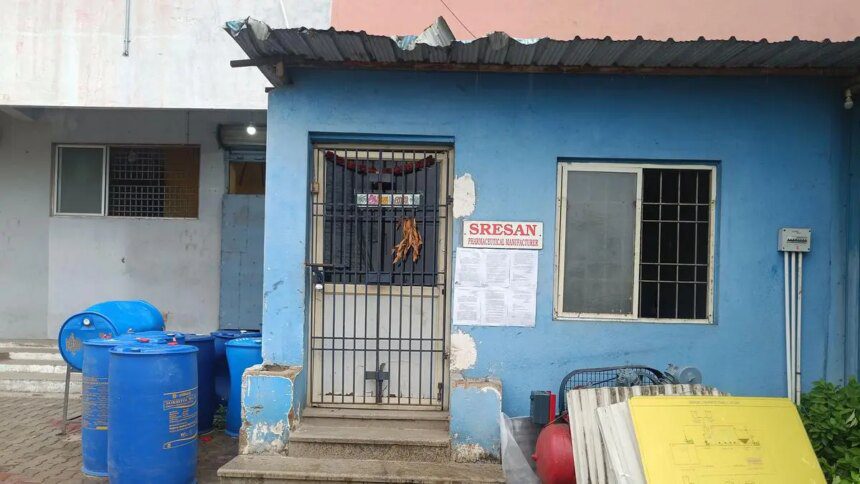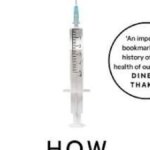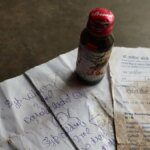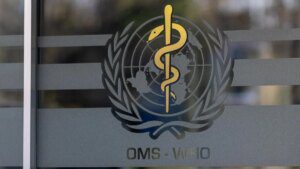Behind the worn blue walls of a shed, resembling a storage space for the adjacent two-wheeler showroom, lies the manufacturing plant of the now-defunct Sresan Pharmaceuticals. This facility’s cough syrup has been implicated in the deaths of over 20 children in Madhya Pradesh.
Situated along the Bengaluru Highway in Sunguvarchatram, approximately 60 km from Chennai, this unremarkable manufacturing unit is adorned with show-cause notices. On its porch are numerous blue chemical barrels, some labeled ‘sorbitol’ and ‘liquid glucose,’ but no indicators are visible of the tragedy caused by Sresan’s cough syrups, specifically Coldrif.
Regulatory authorities, who wish to remain anonymous, have noted that this facility warranted risk-based inspections. Following the fatalities and at the request of health officials in Madhya Pradesh, Tamil Nadu drug regulators inspected the site, uncovering 39 critical observations and 325 major issues. These findings included unsanitary storage conditions, rusted and leaking equipment, and the use of non-pharmaceutical grade raw materials. Additionally, the Coldrif syrup (batch SR-13) was found to contain 48.6 percent diethylene glycol (DEG), significantly exceeding the permissible level of 0.1 percent. DEG, a toxic industrial solvent, poses serious health risks, including kidney failure and death.
Consequently, Sresan’s manufacturing license, initially granted in 2011, was revoked, and a number of senior drug inspectors were suspended for failing to inspect the facility and intervene. Sresan Pharma’s proprietor, G. Ranganathan, has since been arrested by Madhya Pradesh police with assistance from Tamil Nadu authorities.
This incident marks Ranganathan’s second attempt in the pharmaceutical industry; records from the Ministry of Corporate Affairs indicate two launches in 1990 and 2017. Sresan Pharmaceuticals Ltd, registered in 1990, was marked as “strike off” by the MCA in 2009, rendering it defunct. However, in July 2017, Ranganathan established a sole proprietorship named ‘Sresan Pharmaceutical Manufacturer,’ as seen in GST filings. By 2020, the firm was listed in an unstarred question in the Lok Sabha regarding essential drug manufacturers from Tamil Nadu, indicating ongoing operations.
Recent GST filings characterize Sresan’s business as the manufacture of “haematinics and erythropoietin preparations” for treating anemia and cancer, as well as cough and cold syrups containing ingredients such as promethazine, chlorpheniramine, astemizole, and cetirizine.
Experts question the integrity of the manufacturing process, specifically the possibility of DEG contamination. Ganadhish Kamat, former global quality head at Dr. Reddy’s Laboratories, argues that the presence of DEG is a clear indication of adulteration rather than contamination. According to Prashant Reddy, a lawyer and author of The Truth Pill: The Myth of Drug Regulation in India, state governments are primarily responsible for inspecting facilities, as the law mandates annual inspections, which are rarely conducted.
Kamat further points out the disparity in regulatory practices across states, citing the US FDA’s transparency in inspection reports compared to the limited access in India. He criticizes the outdated nature of India’s drug laws, specifically the Drugs and Cosmetics Act of 1940, advocating for compliance with global standards.
Despite the implementation of revised Schedule M rules regarding good manufacturing practices in June of last year for large manufacturers, micro, small, and medium-sized enterprises (MSMEs) have received an extension until December 31, 2025. Kamat believes that adherence to these requirements could have averted the crisis related to Sresan’s cough syrup.
With states often acting independently, the need for unified regulation has been highlighted by officials like Sumant KR Tiwari from the FDA in Jharkhand, who calls for a singular regulatory framework across the country. The central government is reportedly considering new legislation to replace the 1940 Drugs and Cosmetics Act.
Kamat also emphasizes India’s inadequate pharmacovigilance, arguing that adverse reactions to medications are often not communicated effectively. He notes that the cluster of deaths in one area drew attention to the issue, raising concerns that many more children could have been affected without this unfortunate aggregation.
The call for rigorous implementation of drug regulations and practices persists as experts question how many more lives must be lost before effective measures are taken to ensure public safety in pharmaceutical manufacturing.










